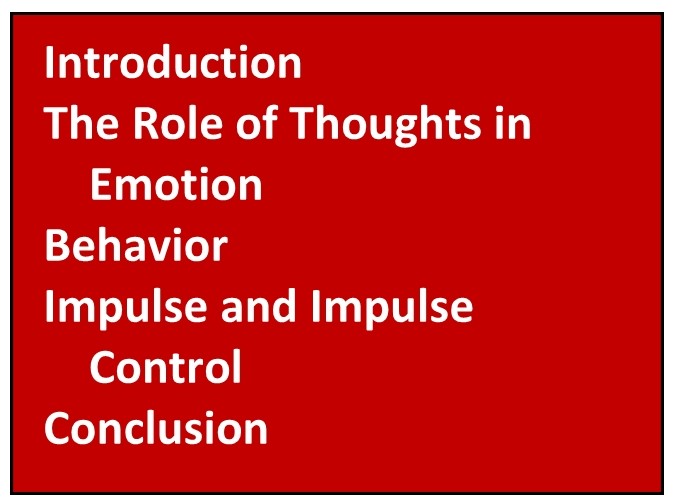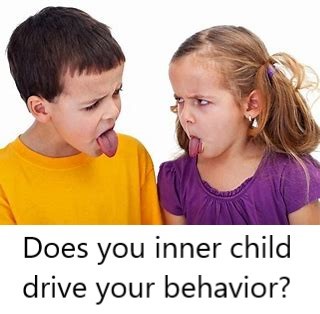Emotions (VI): Thoughts, Behavior, and Impulses
INTRODUCTION
This is the final Letter describing our exploration of emotions. We said that emotion is comprised of feeling and thought and explored emotions and feelings. We now consider the role that thoughts play in our emotions and develop some understanding about behavior and impulses. These ideas will give us increased control over our actions and increased confidence in our spontaneous behavior. Some of the ideas presented here may seem obvious yet fully putting them into practice is challenging and empowering.
Point of Empowerment: Powerful ideas are straightforward and understandable and challenge us to reach our potential by putting them into action.
This Letter includes some ideas that could be considered “speculation.” We also allude to the “self”—the complex person that we are that is full of aspects and parts. The Points of Empowerment are designed to empower us, to make us more powerful. We also introduce a rather complex analytical tool that will be developed further in the future. Finally, we take a brief look at the larger context of emotions as they work with our needs.
THE ROLE OF THOUGHTS IN OUR EMOTIONS
Consider a bowl holding something like nuts. The bowl has a shape that is its form and has the function of holding things. The nuts are the contents (content) of the bowl. Similarly, emotions are a form with specific characteristics—their “shape,” have a function, functioning, and contents. The content of emotions are thoughts and feelings.
Point of Empowerment: Form, function, and content are profound ideas that can help us understand much of our world.
As content, thoughts tell our muscles exactly what to do. Go to bed to fall asleep. Tell your spouse that you love her. Grab your child to keep him from running into the street. Tell your boss to go to hell. Hurry to get to work on time. Say this. Don’t say that. Clearly we do thousands of things each day that are directed by the thoughts we think. This is important because we can change what we think to do something different, something more effective at getting us what we want. This may seem obvious but we don’t fully appreciate our ability the change our thoughts.
Point of Empowerment: Recognize and appreciate the power of changing your thoughts to change your life and the freedom you have to make those changes.
Also remember, when we seek change there is always resistance to change. One resistance to changing our thoughts is that making a change seems to imply that we were “wrong” and we don’t want to admit that we were “wrong”. In reality, at any moment in our lives we are doing the best we can with what we know as reflected in our thoughts.
Thoughts, as a component of emotion determine and carry forth the direction that we will go in. Are we going forward or backward, up or down, inward or outward, constructive or destructive, seeking more or wanting less? Forward and backward can be about change, up and down about our levels of our personal development. Inward or outward can be about the focus of our attention, constructive or destructive about creating or destroying. (Destroying is not automatically “bad”. For example, it is necessary that we destroy things in our life that are not good for us.) If we start with the desire to increase pleasure and decrease pain, knowing the direction that we are heading in can help us see what we are creating for ourself. For example, by focusing our attention inward we can see more clearly what we are feeling and ask, “Is this behavior driven by this feeling causing me more pleasure or more pain?”
We may ask, “How do thoughts combine with feelings to generate neurological impulses?” Our brain working with our conscious and subconscious minds has the ability to convert emotions into the electrical impulses that carry instructions to our muscles. The brain and the conscious and subconscious mind include emotions as they send neurological impulses throughout our entire body through our nervous system. This is what is known as the mind body connection. We have yet to understand exactly how this works but the idea that everything contains consciousness/thought and energy/feeling might help as we seek this knowledge.
BEHAVIOR
Behavior is what we do, the actions we take. We have been saying that what we do (and say) is the result of the thoughts and feelings contained in the neurological impulses that travel to our muscles. Therefore, one clue to our thoughts and feelings is to observe our behavior. This may sound obvious but how often do we examine our behavior with the purpose of determining what we think and feel? For example:
- I told my partner that I liked it when he hugged me. The feeling was love. The thought was, “This feels good, I would like more of this.”
- I told my partner that I was going to hit him (or divorce/leave him). The feeling was anger and rage. The thought was, “I can’t stand to be treated this way, this needs to change.”
- I went to the movies. The feelings were boredom and excitement. The thought was, ”I like the movies, I will feel better if I go.”
- I quit my job. The feelings were relief and excitement. The thought was, “This job has been intolerable for a long time, I need something different.”
- I got something to eat from the refrigerator. The feeling was hunger. The thought was, “Food will satisfy my hunger, something good will bring me pleasure.”
These examples illustrate how every action has a thought and a feeling that drives it.
Point Of Empowerment: The process of identifying the thought and feeling behind a behavior is liberating, freeing us from the automatic actions that control our life giving us the opportunity for conscious choice about our actions.
We have behaved in a certain way and gotten a reaction to that behavior. The reactions of others to our behavior is feedback, feedback about the consequences of our behavior. The reaction we got was something we wanted or something we did not want. We could repeat the behavior if we want or change it. If we decide to change the behavior we need to know what thought and feeling drove it. For example, in anger I cursed at my child who then felt hurt and started crying. I felt badly that I caused her unnecessary pain. Since I want to stop cursing, I identify the angry feeling and thought and consider alternative ways of thinking that will generate patience and patient behavior. The old thought might be “I can’t stand my child’s behavior and think and fear that this behavior will never change.” The new thought might be, “This is an unrealistic thought and fear because I know that the behavior will change when I work on it if I have patience and a strategy for change. My new strategy is to recognize when I feel angry, relax by taking some deep breaths, count to ten before acting, and develop a behavior modification approach to change my child’s behavior.”
IMPULSES AND IMPULSE CONTROL
Sometimes we act on an impulse giving it expression through our behavior and somethings we don’t. Our actions exist in a range, a continuum, from spontaneous to deliberate. Spontaneous actions contain less self-aware thought. We do not seek to control our behavior but prefer immediate expression. Deliberate actions contain more self-aware thought and conscious choice. Both types of actions are valuable. We often move from spontaneous to deliberate and back to spontaneous action. For example, I ate a new food thinking that it would be interesting and feeling curious but not giving it much thought. Since I hated it I will avoid it in the future.
When do we act on an impulse? When don’t we act on an impulse but control our behavior instead exerting “impulse control?” Two of the factors involved in this decision are fear of negative consequences and our conscience. “I wanted to curse at my friend but I stopped myself because I didn’t want her to get angry at me and it would be the wrong thing to do.” We may have a tendency to act on impulses or a tendency to think first. This can be part of our “temperament.” Whatever we do, self-observation and observing the reactions of other’s to our behavior is an important skill that we can use to repeat behaviors we are happy with because they get us what we want and change behaviors we don’t like because they do not get us what we want.
Point Of Empowerment: Impulse control comes from learning about the consequences of our behavior, anticipating what may happen in the future as the result of our behavior, awareness of our impulses before we act on them, and a conscious choice about acting or not acting on an impulse.
What happens if you don’t act on an impulse? If the impulse is important (in a constructive/positive or destructive/negative way) and strong, the impulse will repeat, seeking expression. We can have conflict withing ourselves about acting on positive impulses because we hold ourselves back from achieving the best life has to offer. One type of negative/destructive impulse we may struggle with is a compulsive, a “must,” impulse that can be almost impossible to control. These are compulsions and addictions. We cannot easily stop acting on these impulses though we may want to. These impulses represent complex problems and complex issues. We deserve self-compassion as we wrestle with them.
An approach to dealing with complex issues that starts to address the origins of our thoughts is what we might call self-reflection. This approach contains four aspects: attention, intention, action, and image. As we work with aspects of our self we can engage the complexity of some of our problems. Some definitions:
- Attention: where we place our awareness.
- Intention: the larger picture of what we hope to accomplish with a specific behavior. Purpose expresses the intention of a behavior in a specific situation.
- Action: what we do at a specific moment in time.
- Image: refers to a self-image, a complex picture that we hold of an aspect of our self. We have many self-images. “I see myself as a generally loving person.” Or “I see myself as a generally incompetent person.”
An example of applying this process: I am 35. My frequent arguments with my mother leave me feeling drained and guilty. I pay attention to every little annoying thing that she does. My intention is to express my anger and show her how wrong she is. In action, I yell at her, criticize her, or provoke her with some “nasty” comment. In relation to my mother I hold an image of myself as a “raging child.” I want to change my behavior. Having broken down my unwanted behavior into these aspects, I can now address each one to produce change.
Point Of Empowerment: Behavior shows you your thoughts and feelings. Your thoughts and feelings tell you about who you are, about your “self.”
A thought about the larger picture, the context of emotions and behavior: the purpose of all of our behavior is to fulfill our needs: survival, safe/security, belonging/loving, self-esteem, to create/produce/know, self-actualization, and beauty/mystery/transcendence. In seeking to fulfill our needs we generate many intentions, purposes, and motivations which create the thoughts and feelings that drive behavior.
CONCLUSION
This concludes our exploration of the nature and functions of emotions. Hopefully these ideas bring you the greater understanding that furthers your personal development and the development of your human potential. We live in the Age of Empowerment where we have the knowledge that helps us to be whoever we want to be.
